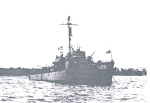Propulsion: Two 1,440bhp General Motors 16-258S diesel engines (Serial No. 7796 and 7797), Farrel-Birmingham single reduction gear, two shafts.
Click on thumbnail
for full size image |
Size |
Image Description |
Source |
USS PC-1120
|
 |
46k |
- |
E. J. Comeau
PC 553/1228 |
 |
30k |
31 July 1944
Off Sansapor, Dutch New Guinea. |
Bob Daly/PC-1181
and Edward R. Middleton, S-1/C, USNR
Crew Member 1946 |
M/V Ohana Kai
|
 |
68k |
c. 1977
Honolulu, HI |
Bob Daly/PC-1181 |
There is no DANFS history available for Carlinville (PC-1120)
History of PC-1120 The sub chaser was built by the Defoe Shipbuilding Corporation of Bay City, Michigan. Her keel was laid down as Defoe hull #205 on Friday, 19 June 1942 and launched as the PC-1120 on Monday, 24 August 1942. After fitting out at the company docks, she was delivered to the Naval Base in New Orleans where her crew came aboard. She was commissioned on Monday, 18 January 1943 with Carl S. Moliter, LCDR, USNR in command. After eight weeks of intense training at the Subchaser Training Center (SCTC) in Miami and ASW instruction in Key West, Florida, the subchaser was assigned to Western Pacific duty. Underway by convoy, they transisted the Panama Canal, headed north to San Diego and then west to Pearl Harbor. They arrived in the Solomon Island area in mid-1943. They spent the rest of 1943, all of 1944 and most of 1945 with the 7th Fleet and the 7th Amphibious force performing escort, convoy and patrol work during the many island landings.
They were involved with the landings on Arawe on New Britain on 15 December 1943 and the 4th and 13th January of 1944. This was followed with the Eastern New Guinea Operations with the landings on Saidor. Next came the Western New Guinea operations with the landings at Biak Island, Noemfoor Island, the Cape Sansapor Operations and the Morotai landings between 18 June 1944 and 15 September 1944.They participated in the landings on Leyte between 15 thru 25 October 1944 and the Borneo Operations with the landing at Tarakan Island.With the consolidation of the Southern Philippines they were involved in the Palawan Island landings from 28 February thru 3 March 1945. On V-J Day they were at the Subic Bay Naval Base on Luzon in the Philippines. During this tour of duty they shot down three Japanese aircraft. A twin engined Mitsubishi "Betty" bomber and two Mitsubishi "Zero" fighter aircraft.The ship was awarded six battle stars for its service in the Asiatic/Pacific Theater and the Navy Occupation Service (Asia) medal for service between 8 October 1945 thru 14 April. The subchaser returned to the CONUS (Continental limits-USA) arriving at Portland, Oregon in July of 1946.By January of 1947 she had been decommissioned and put in the Reserve Fleet at the Columbia River Fleet Anchorage, Tongue Point, Astoria, Oregon.On February 1, 1956 she was given the name Carlinville. In April of 1959, she was turned over to the Maritime Commission to be sold to a Carl Swanson who sold it to an Alaskan fisherman. He reactivated it and put some fish machinery aboard and drove her up to Kodiak Island and went fishing with her. Things didn't work out and he ended up with financial problems.In 1975, the ex-subchaser was owned by the Diesel Electric Company of Seattle and working in the Hawaiian Islands as the M/V Island Transport.In 1976 she was seized by the U.S. Marshal in a bankruptcy ruling and sold to the Greenpeace Organization for $70,000 to be used to harass the Russian whaling fleet which was operating south of the Hawaiian Islands. She was cleaned up and painted white. Registered in Panama, she was renamed the M/V Ohana Kai (Hawaiian for "Children of the Sea").Crew member Dick Dillman stated that they were told that the Ohana Kai would do 22 knots. "With her badly fouled bottom and worn out General Motors diesels, she could hardly make 14 knots. We left a trail of black smoke that could be seen for miles and had to shut down one engine because of a major mechanical failure of its supercharger blower. We finally found the whaling fleet
but all we did was to hove to and watch the Zodiac boats harass the Russian ships."The Ohana Kai returned to San Francisco in late 1979 and was anchored out. For a few years it became a eco-hippie floating flophouse before it was sold to a group that wanted to take it crab fishing. This never happened and the ship was tied up to a wharf in the east bay for quite some time. Finally a December storm tore it from its moorings and it ended up on the mud flats off Emeryville.The city of San Francisco took over the jurisdiction
of the vessel and sold her to Claus Von Wendel, a veteran of the German Merchant Marine. The engine room
equipment was removed and sold. The hulk was towed to Berkeley and moored in the North Marina Basin.
Von Wendel and his family used it as a "live-aboard." His daughter Anne was born aboard this vessel. Von Wendel has been described as a water front character and had
a commune of derelict ships at the Marina. It became sort
of a "hippie" hang-out with Claus as their leader. He became a bishop in his own religion and sold charters in his
religion as a tax write-off scam.
1991 - After many years of court orders and law
suits, the city of Berkeley and the owners of the marina
had Von Wendel and his navy evicted. In April of 1991,
the ex-PC-1120 was towed to a scrap yard in Alameda
for
disposal.
R. W. Daly/PC-1181
Additional Resources and Web Sites of Interest
Patrol Craft Sailors Association
This page created by Gary P. Priolo and maintained by Tom Bateman

|